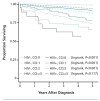Aging, inflammation, and HIV infection
- PMID: 22954610
- PMCID: PMC6148943
Aging, inflammation, and HIV infection
Abstract
Prolonged survival in HIV infection is accompanied by an increased frequency of non-HIV-related comorbidities. A number of age-related comorbidities occur earlier in HIV-infected patients than in individuals without HIV infection. This "accelerated aging" appears to be largely related to chronic inflammation, chronic immune activation, and immunosenescence in HIV infection. Levels of markers of inflammation and coagulopathy are elevated in HIV-infected patients, and elevations in markers such as high-sensitivity C-reactive protein, D-dimer, and interleukin 6 (IL-6) have been associated with increased risk for cardiovascular disease, opportunistic conditions, or all-cause mortality. In both HIV infection and aging, immunosenescence is marked by an increased proportion of CD28-, CD57+ memory CD8+ T cells with reduced capacity to produce interleukin 2 (IL-2), increased production of IL-6, resistance to apoptosis, and shortened telomeres. A number of AIDS Clinical Trials Group studies are under way to examine treatment aimed at reducing chronic inflammation and immune activation in HIV infection. This article summarizes a presentation by Judith A. Aberg, MD, at the IAS-USA live continuing medical education course held in New York City in October 2011.
Conflict of interest statement
Financial Disclosure: Dr Aberg has been a scientific advisor to Merck & Co, Inc, Tibotec Therapeutics, and ViiV Healthcare. She will receive clinical research support to be awarded to New York University School of Medicine from Kowa Research Institute in 2012. (Updated 06/13/12)
Figures


References
-
- van Sighem AI, Gras LA, Reiss P, Brinkman K, De Wolf F, ATHENA Cohort Study Group. Life expectancy of recently diagnosed asymptomatic HIV-infected patients approaches that of uninfected individuals. AIDS. 2010;24(10):1527-1535. - PubMed
-
- Thompson MA, Aberg JA, Cahn P, et al. Antiretroviral treatment of adult HIV infection: 2010 recommendations of the International AIDS Society-USA panel. JAMA. 2010;304(3):321-333. - PubMed
-
- Thompson MS, Aberg JA, Hoy JF, et al. Antiretroviral treatment of adult HIV infection: 2012 recommendations of the International Antiviral Society-USA panel. JAMA. 2012;308(4):387-402. - PubMed
-
- Palella F, Armon C, Buchacz K, et al. CD4 at HAART initiation predicts long-term CD4 responses and mortality from AIDS and non-AIDS causes in the HIV outpatients study. [Abstract 983.] 17th Conference on Retroviruses and Opportunistic Infections (CROI). February 16-19, 2010; San Francisco, CA.
-
- Bini EJ, Green B, Poles MA. Screening colonoscopy for the detection of neoplastic lesions in asymptomatic HIV-infected subjects. Gut. 2009;58(8):1129-1134. - PubMed
Publication types
MeSH terms
Substances
LinkOut - more resources
Full Text Sources
Other Literature Sources
Medical
Research Materials
